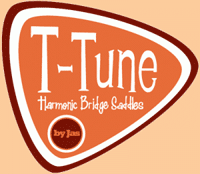The intonation of a guitar is accurately set when the note produced by fretting a string at the 12th fret is exactly one octave higher than the note produced by playing the same string open OR when the note produced by fretting a string at the 12th fret is exactly as high as the 12th-fret harmonic. The 12th fret marks the centre of the scale length and is the midway point between the nut and the bridge.
Because the portion of the string that makes contact with the bridge saddle is rigid, the string does not vibrate directly from this position but from a point just in front of the saddle. This results in a shortening of the “speaking length” of the string in relation to its scale length of between 1-5 mm, depending on the string gauge. This means that if we set the bridge saddles so that the point of contact between saddle and string corresponds exactly to the scale length (double the distance from the nut to the 12th fret; all saddles in a row), without taking the rigid, non-vibrating part of the strings into account, notes played at the 12th fret will, as a rule, be sharp – because the strings are “too short”! If we wish to achieve the correct pitch, we have to “lengthen” the strings in order to compensate for this anomaly – even more so in the case of heavier gauge strings, which are even more rigid. Adding the length of the non-vibrating part of the string to its speaking length in this way can be described as “octave compensation”.
Quick set-up:
-
Hold the guitar in its normal playing position and plug it in to an electronic tuner. Tune all of the strings.
- Play the open top E string and check that the display is showing “0” – for in tune. Now fret the string at the 12th fret and play it; check the pitch displayed on the tuner.
-
If the reading is to the right of “0”, the bridge saddle will have to be moved to the right; if the reading is to the left of “0”, the bridge saddle will have to be moved to the left. The saddle only has to be adjusted by millimetres or fractions of a millimetre; the electronic tuner will tell you how much. Keep repeating this procedure until the string is in tune. Set-up the remaining strings using the same method.
Important: Always remember to slacken the string tension before adjusting the height or position of the bridge saddle.
Getting a guitar neck “in tune with itself”
originally referred to the accurate positioning of the frets on the fingerboard. Most guitars made today have accurately positioned frets, so an “out of tune” neck as a result of sloppy fret positioning is a rarity.
An “in tune” neck is often taken to mean that each individual fret has accurate pitch. In order to achieve this, a number of preconditions have to be fulfilled:
-
The strings must not be too old or be overstretched. Accurate pitch is best achieved with new strings.
-
The string slots in the nut must be exactly the right depth. The lowest point in the nut must be exactly the same height as the first fret. If it is higher, the player will be forced to bend the string by exactly the same amount in order to compensate for this, thereby causing the fretted notes to be sharp. The closer the string is played to the nut, the sharper the notes will be. If the nut is too low, fret buzz will occur when the strings are played open. The “neck relief” (concave forward bow of the neck) should be minimal (0.2-0.7 mm). Too much neck relief unnecessarily increases the distance between string and fret and – just as in the case of a too high nut – results in unwished-for pitch raising due to compensatory bending of the string. This is particularly noticeable in the mid-positions of the neck. If the neck is too straight or has a convex bow, fret buzz will occur even if the height of the nut is correct. The intonation can be set once the nut height and neck relief have been adjusted. Afterwards, the guitar usually has a neck which is “in tune with itself”.
Point of contact between bridge saddle and string
The distance between these points on the T-Tune HBS double saddles corresponds to the average distance between these points on two neighbouring single saddles (of six).






